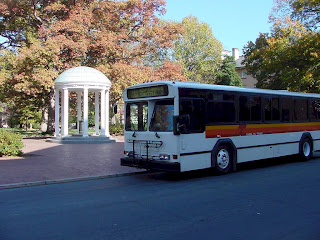Wednesday, October 3, 2007
Sunday, September 30, 2007
Tuesday, September 25, 2007
September 21st Research
Last Friday, the group assembled at various locations and times across Chapel Hill to survey patrons of the bus systems. The patrons were asked several quick questions to gauge their appreciation for and use of the public transportation network. Also, they were asked to participate in quasi-mental mapping, in order to provide data on their perception of bus routes and their extent of usage of a particular bus line.
We intentionally staggered our timing and choice of bus systems in order to collect a wider swath of data from a variety of demographic groups. As a result, we were able to survey a more accurate representation of the agents on the transportation network without regard to class, reason for using the system, or people who use the bus at times other than the times typical for the beginning and end of the capitalist work day.
We intentionally staggered our timing and choice of bus systems in order to collect a wider swath of data from a variety of demographic groups. As a result, we were able to survey a more accurate representation of the agents on the transportation network without regard to class, reason for using the system, or people who use the bus at times other than the times typical for the beginning and end of the capitalist work day.
Sunday, September 9, 2007
First Meeting
Our group met in the Pit on Friday to discuss revisions to our complex question, as well as to develop a plan for our research. We have decided to focus on how the usage of the public transportation network varies as the day progresses, in terms of their purpose for boarding. We developed a very brief questionnaire (so that we can refrain from wasting travelers' time and to maximize our ability to collect a broad survey) that first asks whether the person is using the bus for either school, work, leisure, or other usage. Next, we will ask for a simple 1-5 scale rating on the overall satisfaction of the bus. This seems elementary for a university-level research project, however, documenting the sociological attitude of the riders towards the bus will help to explain if the bus system has flaws that are impeding its usage in the city or if the buses are satisfactory to entice riders to board. Also, we will ask how often the person uses the bus via a batch of options, like twice-a-day, twice-a-week, etc., so that we may glean more information than we could gather firsthand in order to extrapolate our findings to wider spectra of times.
Finally, we will have markers so that riders can sketch a brief mental map of where they understand their respective bus travels. This exercise will allow our team to determine more information about how citizens use the bus, and how their understanding of the system either augments or hinders their usage of Chapel Hill's public transportation.
Finally, we will have markers so that riders can sketch a brief mental map of where they understand their respective bus travels. This exercise will allow our team to determine more information about how citizens use the bus, and how their understanding of the system either augments or hinders their usage of Chapel Hill's public transportation.
U Bus in front of the Old Well
Subscribe to:
Posts (Atom)







